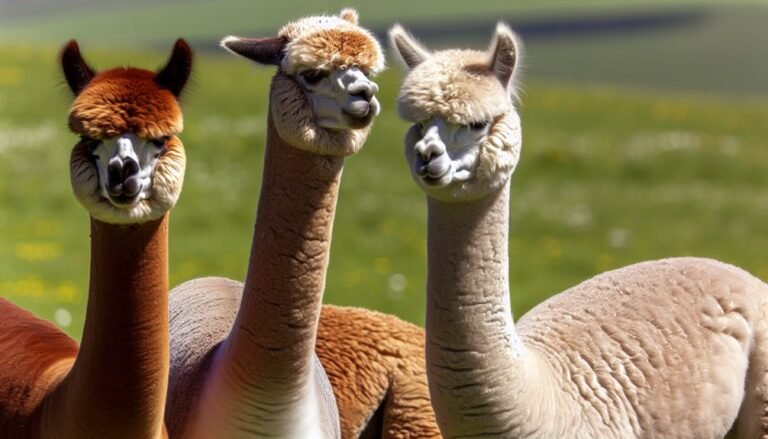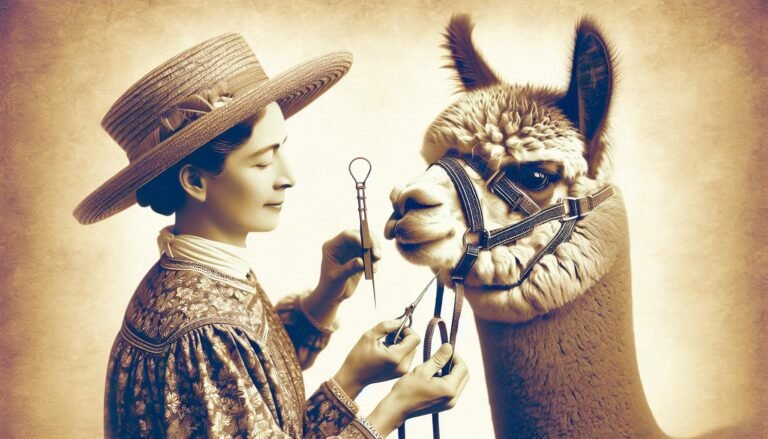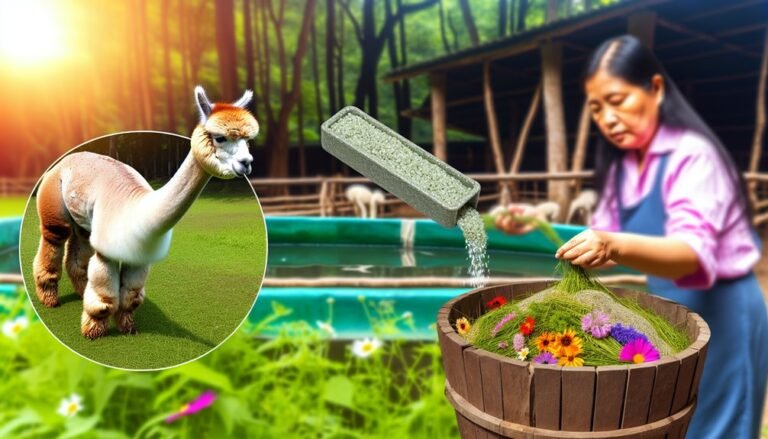How to Selectively Breed Alpacas: Best Practices
To selectively breed alpacas effectively, you’ll want to focus on genetic traits like fiber fineness and color by reviewing lineage and using tools like Expected Progeny Differences (EPDs). Make sure your alpacas are mature and healthy before breeding, monitor female receptiveness, and keep thorough records of matings and outcomes. Careful timing and pregnancy checks improve success rates. By applying these strategies, you’ll set a strong foundation for improving your herd’s quality and sustainability while exploring even more detailed breeding insights.
Key Takeaways
- Use color genotyping and Expected Progeny Differences (EPDs) to predict and select desirable offspring traits like fiber quality and color.
- Confirm alpacas’ maturity and health with thorough checks, vaccinations, and behavioral monitoring before breeding.
- Maintain detailed breeding records, including lineage, mating dates, and outcomes, to track genetic compatibility and improve pairings.
- Monitor pregnancy through ultrasound after 60 days and watch for physical signs to ensure successful gestation and reduce early abortion risk.
- Create a stress-free environment, isolate selected males with females, and plan breedings during optimal weather for healthier crias.
Understanding Genetic Traits and Selection Criteria

When you’re selecting alpacas to breed, understanding their genetic traits is key to achieving your goals. You’ll want to use color genotyping to predict offspring colors by analyzing the genetic backgrounds of your breeding pairs. Expected Progeny Differences (EPDs) offer valuable insights into trait inheritance, especially fiber characteristics like fineness and density, helping you improve your herd’s quality. Regularly reviewing lineage data through the Alpaca Owners Association registry guarantees genetic compatibility and avoids inbreeding. Effective breeding management means aligning your selection with specific desirable traits, such as fineness or uniformity, to produce quality alpacas that enhance your herd’s value. By focusing on these genetic tools and criteria, you can make informed decisions that support sustainable, selective breeding success.
Preparing Your Alpacas for Breeding
Before you begin breeding your alpacas, it’s essential to confirm they’ve reached the right maturity—females between 15 and 18 months and males between 24 and 36 months—to avoid health complications and improve success rates. Conduct thorough health checks and vaccinations on both male and female alpacas to verify they’re in prime condition for breeding. Keep a detailed breeding record to track genetic lineage, mating dates, and outcomes. Create a stress-free environment during the breeding process, as males may need calm surroundings and experienced females can help guide them. Monitor female alpacas for behavioral signs like cushing to determine receptiveness. After mating, use the spit test to confirm pregnancy and better manage the gestation period, assuring timely care and intervention if necessary.
Managing Breeding Techniques and Timing
Once your alpacas are healthy and ready for breeding, managing the techniques and timing becomes your next focus. Use the spit test to assess female receptiveness, confirming she’s not pregnant and ready for mating 7 to 14 days post-breeding. Plan breedings around ideal weather conditions, aiming for spring births to enhance cria health. You’ll want to manage breeding carefully by isolating females with selected males to reduce injuries and improve success rates. Consider each female’s age and health status—usually ready at 2 years—and monitor reproductive patterns to identify prime ovulation timing, especially after shearing. Keep detailed records to track successful pairings, which helps refine your breeding programs and improve your overall breeding stock quality over time.
Monitoring Pregnancy and Gestation

Although alpaca gestation usually lasts around 11.5 months, you should be prepared for variations that can extend up to 400 days. Early pregnancy confirmation is vital due to an early abortion rate of 7% to 25%. You can use the spitting-off method, where pregnant females spit at males, as a simple indicator. Ultrasound scanning after 60 days offers more reliable confirmation but requires skilled operators to avoid false negatives. As gestation progresses, close monitoring becomes necessary. Visible signs of pregnancy such as abdominal swelling and fetal movements typically appear in the last month. Observing these signs helps you guarantee the dam’s health and readiness for birthing. Consistent monitoring throughout gestation supports the wellbeing of your alpacas and the success of your breeding program.
Utilizing Data and Records for Informed Breeding Decisions
When you want to improve your alpaca herd, using detailed data and records is essential for making informed breeding decisions. You’ll rely on accurate breeding records and health documentation to monitor genetic traits and overall herd quality. Employ EPDs to predict trait inheritance, helping you select ideal pairings. Color genotyping guides strategic pairings by forecasting cria color outcomes. Don’t overlook fleece traits; analyzing histograms of fineness and density refines fiber quality goals. Regular performance assessment guarantees your breeding strategies align with herd needs.
Leverage precise data and genetic tools to enhance alpaca breeding and fiber quality effectively.
- Maintain thorough breeding records and health documentation to track lineage and performance.
- Use EPDs and color genotyping for precise selection based on desired genetic and color traits.
- Analyze fleece trait data to enhance fiber quality through targeted breeding decisions.
Frequently Asked Questions
At What Age Should You Stop Breeding Alpacas?
Imagine a knight’s armor protecting alpacas; you shouldn’t breed females past 12 years and males after 10-12 years to safeguard alpaca health, respect reproductive lifespan, maintain genetic diversity, and consider ethical breeding frequency and offspring care.
What Is the Mating Ritual of Alpacas?
You’ll notice alpacas’ mating behavior includes a courtship display where females show receptivity by cushing. Males assert dominance with vocal communication during breeding season, influencing mating frequency, reproductive health, gestation period, and eventual cria care.
Is There Money in Breeding Alpacas?
You can make money breeding alpacas if you manage breeding costs and focus on genetics importance to improve fiber quality. Understanding market demand, alpaca prices, and industry trends helps optimize profit margins despite investment risks and boosts sales opportunities.
How Many Times Can You Breed an Alpaca?
Like clockwork, female alpacas breed once yearly due to their reproductive cycles and 11.5-month gestation period. You’ll focus on male selection, breeding frequency, health considerations, and maintaining breeding records to guarantee genetic diversity and fiber quality.








Our picks
Alpaca & Wool Felted Sole Inserts: Comfy Upgrade?
Best Alpaca Socks for Hiking: Ultimate Comfort and Durability on Trails
Best Alpaca Halter for Comfort and Control